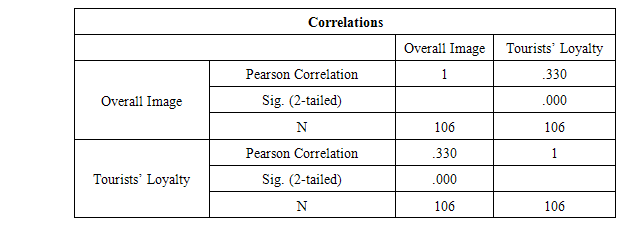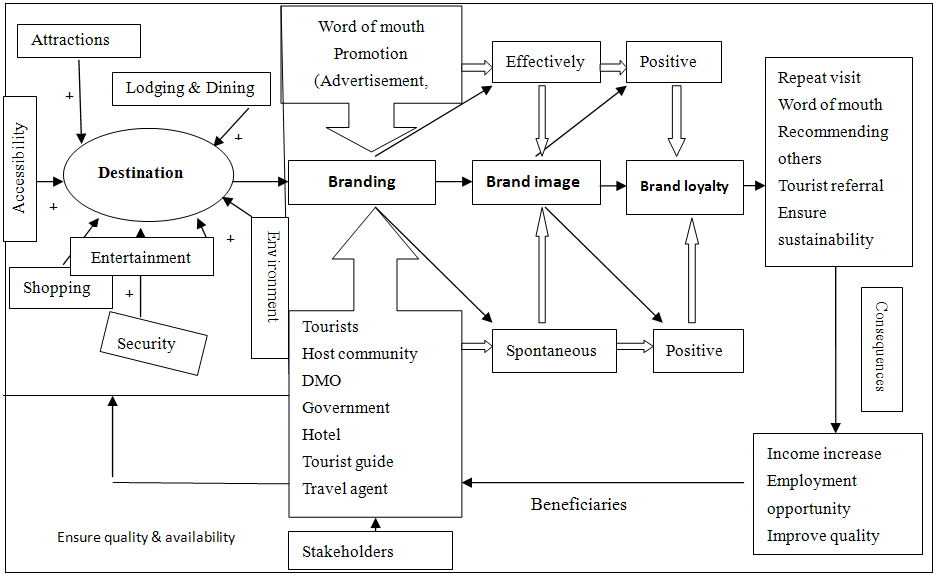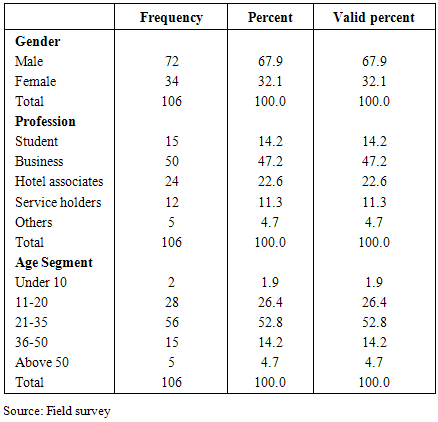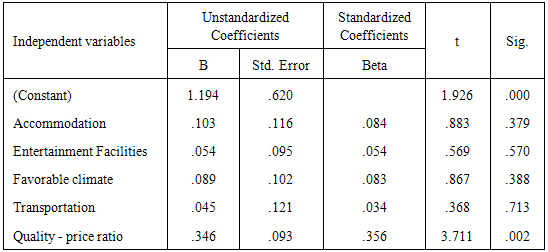-
Paper Information
- Next Paper
- Paper Submission
-
Journal Information
- About This Journal
- Editorial Board
- Current Issue
- Archive
- Author Guidelines
- Contact Us
American Journal of Tourism Management
p-ISSN: 2326-0637 e-ISSN: 2326-0645
2015; 4(2): 27-34
doi:10.5923/j.tourism.20150402.01
Building a Strong Brand Image of Cox’s Bazar as a Tourist Destination: An Empirical Analysis on Cox’s Bazar
1Dept. of Tourism and Hospitality Management, University of Dhaka, Dhaka, Bangladesh
2Faculty of Business Administration, Cox’s bazar International University, Cox’s bazar, Bangladesh
Correspondence to: Biplab Roy, Dept. of Tourism and Hospitality Management, University of Dhaka, Dhaka, Bangladesh.
| Email: |  |
Copyright © 2015 Scientific & Academic Publishing. All Rights Reserved.
The study was carried on Cox’s bazar, the longest unbroken sandy sea beach also known as a tourist hub of Bangladesh. The aim of the study is to build strong brand image of Cox’s bazar as a tourist destination on the basis of tourist’s perception regarding different attributes of tourism. Building a strong brand image of a destination is the process of earning reputation for a destination by utilizing its resources and opportunities, which are original and inspiring to the outer world. The study was based on primary as well as secondary data; applied quantitative method and 106 questionnaires were used. Multiple regression analysis, correlations and a model fit to destination loyalty is being constructed to analyze different attributes of tourism. From the study it is stated that there is significant relationship between image attribute and overall image of tourists towards Cox’s bazar as a destination and a positive correlation between destination overall brand image and tourist’s loyalty. The findings of the research are expected to assist concerned authorities, planners, and marketers to ensure availability and quality of necessary tourism components that will help to build strong brand image of Cox’s bazar as a tourist destination.
Keywords: Brand image, Brand loyalty, Destination Management Organization (DMO), Quality-Price ratio, Stakeholder, Tourists’ perception, Tourism attribute
Cite this paper: Biplab Roy, Rajidul Hoque, Building a Strong Brand Image of Cox’s Bazar as a Tourist Destination: An Empirical Analysis on Cox’s Bazar, American Journal of Tourism Management, Vol. 4 No. 2, 2015, pp. 27-34. doi: 10.5923/j.tourism.20150402.01.
Article Outline
1. Introduction
- Tourism is one of the fastest growing industries which united the whole world in a village and contributing more to the world economy. International tourism receipts increased by $48 billion in 2014 to reach records $1245 billion, an increase of 3.7% in real terms. International tourists’ arrival also increased by 4.4% in 2014, reaching a total 1135 million, up from 1087 million in 2013. International tourism (travel and passenger transport) represents 30% of the world’s exports of services and 6% of overall exports of goods and services. As a worldwide export category, tourism ranks fourth after fuels, chemicals and food, ranking first in many developing countries [1].Perception about a destination is called brand image of a tourist destination. Otherwise, brand image is the current view of the customer about a brand and a unique bundle of belief within the minds of tourists. On the basis of perception tourists choose their holiday destination. In the modern world where large quantity of information is available and tourists are educated, brand image of a destination play a central role for selecting a destination. Building destination brand image is first step to building destination branding. So it is clear that branding is the second stage of building a favorable destination image. The affect of brand image on tourists’ destination choice is huge, because it is believed that brand image is a mental representation of a set of variables that can motivate and change tourist behavior. In the context of modern marketing, brand image becomes a major factor in the success of any organization [2], and is the result of sensory experiences and internal limitation created by perceptual processes. Brand image can vary from tourists to tourist, time to time because sometimes brand image works as fiction, sometimes as icon. Destinations need to work carefully with brand image because it is defined as sensitive and difficult to work with which will effect on the reputation of a destination. If there is any mismatch between reality and brand perception than it creates negative brand image. Brand image of a destination is formed from several sources and types of information, tourism components of destination, age and level of education, motivation to travel and tourist’s personality. Numerous studies have found that brand image strongly influences both the emotional response of consumers to products and their purchasing behavior. So, it is very much clear that brand image of a destination is a key factor that influences tourists to choose a destination where they will go for their vacation as well as how many times they will go.Cox’s bazar is well known for the longest unbroken sea beach as well as tourist capital of Bangladesh and has huge potentiality for developing as one of the most attractive tourist destination. So the concept of brand image comes automatically to promote such type of tourist destination to domestic as well as international tourists. On the other hand, brand image of Cox’s bazar is a set of perception, association, knowledge, prejudices, imagination and emotional thoughts of tourists about the Cox’s bazar.
2. Overview of Cox’s Bazar-‘Tourist Capital of Bangladesh’
- To see the world’s longest unbroken sandy sea beach, get lost in the wave of sea, feel the beauty of sunset behind the waves with different sky colors at dust, taste the culture of different tribal groups with the heart touching hospitality of local people, enjoy the long drive with nearest and dearest one at Marin drive road, to pass a memorable evening at Barmise market, Cox’s bazar-‘the tourist hub of Bangladesh’ is incomparable. Miles of golden sands, towering cliffs, surfing waves, rare conch shells and delightful seafood, colorful pagodas and Buddhist temples against the picturesque background of a chain of forested hills with rich wildlife made this beach as one of the most attractive tourist spot in the world.120 km long unbroken sandy beach makes the Cox’s bazar unique tourist destination because maximum beach of the world is only one to two km long. It has several destination mainly named Kolatoli, Suganda, Laboni, Inani, Himchori, Teknaf, Mohaskhali, Ramu, Saint Martin Island etc. Nearly two million people visit Cox’s Bazar in the peak season from November to March. Visitors are mainly Bangladeshi nationals and originate from all parts of Bangladesh. Now Cox’s bazar has 154 restaurants, 220 hotels, 54 tour operators, 5000 construction workers working in tourism industry [3]. Around altogether 10000 people are working in the tourism sector in Cox’s bazar and each person maintains a family of 6 persons, then this tourism industry is giving food to the 60000 people [4]. So it is clear that the potentiality of Cox’s bazar as a tourist destination cannot be neglected. On the other hand, socio economic condition of the local community, investors, hoteliers, tour operators greatly depend on the development of tourism industry in Cox’ bazar.
3. Literature Review
- Destination can be seen as an area that includes all services and goods a tourist consumes during his or her stay. A destination according to [5], “is a town, city or a place which has one or more attractions for tourists”. The image is a reflection, sometimes distorted, of its fundamental being, a measure of its health, and a mirror to its soul. Image can be seen as the sum of beliefs and impressions People hold about places. The image of a destination brand can be described as “perceptions about the place as reflected by the associations held in tourist memory” [6]. The most frequently cited definition for destination image is: ‘the sum of beliefs, ideas and impressions that a person has of a destination’. Brand identity and brand image are critical ingredients for a successful destination brand [7], [8]. Destination image is an essential factor for tourist places and better image of the destination bring more tourist towards destination [9]. If any tourism authority can create positive image of the destination on tourist mind then it is easy to be successful in tourism business [10]. Destination image has a key role for tourism marketers. Several researchers [11] have illustrated that destination image and tourists’ purchase decisions are positively correlated; this is an important issue in an individual’s travel purchase related decision making, since the individual traveler’s (dis) satisfaction with a travel purchase depends on a comparison of his/her expectation about the destination or a previously held destination image, and on his/her perceived performance of the destination, it is an important determinant. [12] propounded a framework, in which he cleared out the point that the destination image is built on three components: the overall image, the destination brand and, within it, brand personality. Image as a new component of destination brand associations. The overall image of the destination (i.e., brand image) is a mediator between its brand associations (i.e., cognitive, affective, and unique image components) and tourists’ future behaviors (i.e., intentions to revisit and recommend). Creating a differentiated destination image has become a basis for survival within a globally competitive marketplace where various destinations compete intensely. According to [13], the brand image about a particular tourist destination has a crucial influence on the final choice of destination and on the tourist consumer behavior of different tourist products. Destination branding has primarily focused on analyzing the brand image as this has a direct effect on the tourist consumer behavior. [14] Believes that, in the context of increased competition on the international tourism market, the assessment of destination image has become a research subject for both managers aiming to improve destination positioning and academic researchers. Consumers perceive positive brand image when brand associations are implemented to suggest benefits of purchasing from the specific brand. This then creates favorable feelings toward the brand, and differentiates it from alternatives with its unique image. A strong destination image gives competitive advantage from the competitors [15]. There are three essential factors that help to build a destination image. Firstly, word-of-mouth by the tourists if the tourist spread positive word of mouth then it is easy to build a strong image of a destination. Secondly, image making of media and lastly policies and interest taken by destination government. Destination image play an important role to choose the tourist destinations. Positive destination image enhance chance to visit any favorite destination place and it helps to take decision about any particular destination. A brand that can foster and simplify purchase decisions, reduce purchase risk, create and deliver expectations is invaluable. In the late 1990s, destination branding gained attention in the research of tourism management, yet there remains little research regarding this concept. “Destination brands must go beyond the communication of an image and make the brand promises a reality”.Place branding (also known as destination branding, place marketing or place promotion) is a relatively new umbrella term encompassing nation branding, region branding and city branding [16]. Although branding destinations is a relatively new development [17] and academic investigation in the area is just beginning to emerge, studies on destination image are abundant and can be traced back to the early 70s when Hunt examined image as a development factor (1975). The aim of destination branding is to accentuate the singularity of a tourism brand and present a favorable image of the mentioned brand to a target market and so the marketing communications has become important for destinations to promote their brand identity and brand image to target audiences [18]. Destination branding is the process that allows a destination to be identified and differentiated from other alternatives, through the construction of a message, the brand, which tries to attract tourists and consumption [19]. Destination branding aims to underpin the uniqueness of a tourist destination, show positive images to target markets, and support forming and developing positive images.[20] Empirical research has demonstrated that branding enhances destination image among visitors and assists DMOs in measuring achievements. According to [21], it is clear that destination branding includes image building. A proper management and understanding of destination branding is crucial in certain regions where tourism is a key economic driver. Researchers do agree that in today’s competitive tourism market, destination branding is an effective tactic for building successful tourism images and programs [22]. [23], conducted a study on factors affecting to choose Bangladesh as a tourist destination. The study shows that service quality, natural beauty, security and shopping facility are statistically significant in explaining the intention to select a tour destination in Bangladesh.
4. Objectives
- To build positive perception about Cox’s bazar in the mind of both domestic and international tourists.To evaluate the relationship between brand image and tourist destination.To analyze the tourism components which have significant impact for building strong positive brand image of Cox’s bazar. To identify different attribute of tourism that can be used to build brand image.To explore the current scenario of brand image of Cox’s bazar.Identify the relation between destination overall image and tourists’ loyalty.
5. Limitations
- Data collection was limited to only local community of Cox’s bazar and small size of tourists who visited Cox’s bazar. So, the credibility of research findings is based on small selected sample. Respondents’ awareness regarding destination image and concept of branding is very much confusing. Future research will be undertaken using a bigger sample, for a better understanding of the determinants of the destination’s brand image.
6. Methodology of the Study
- The present study is exploratory as well as descriptive in nature, because different methods of both types of research were used. The study area was selected purposively considering huge potentiality for developing as a tourist destination. All tourists and local people included hotel associates, photographer, kit kot owner, beach boy, tourist police, tribal people, business man of Cox’s bazar are target population and population nature is known and measureable in size. One of the most important aspects of a quantitative research is the good measurement of the phenomena using the selected sample. Simple random sampling technique was used to select sample and sample size was 106 (n=106).A structured questionnaire was constructed for collecting primary data through personal interview and secondary data were collected from relevant research report and publications, newspapers, books, journals and websites. The survey questionnaire consisted of three major sections. The first sections included questions relating to the individual travel behavior of respondents. The travel behavior items included the purpose of visit, preferred season for visiting, positioning element and nature of money spending. The second section was developed to assess the respondent’s perception of overall image toward Cox’s bazar as a tourist destination. 17 items relating to overall image were selected and respondents were asked to rate Cox’s bazar as a tourist destination on each 17 attributes on a 5-point Likert scale where 1 = Strongly disagree; 2 = Disagree; 3 = Normal; 4 = Agree; and 5 = Strongly agree. And the third section included questions relating to the socio-demographic characteristics of respondents and the items included age, profession and gender of respondent. Appropriate statistical analyzes such as frequencies, analysis of variance, and regression analysis were used to analyze the data. Cronbach’s alpha scale was conducted to create as a measure of reliability. The multiple regression analysis was used to finds the casual relation between dependent and independent variable. These statistical analyses were conducted using the Statistical Package for Social Sciences (SPSS 20) software.
7. Hypothesis of the Study
- H1: Ho: No differences exist between image attribute and overall image of tourists towards Cox’s bazar as a destination.H2: Ho: Destination Overall Image has a positive effect on Tourists’ Loyalty.
8. Analysis and Results
8.1. Respondents’ Socio-demographic Profile
- Table 1 provides the respondents’ information. Out of a total of 106 respondents listed for analysis 72 (67.9%) were male and 34 (32.1%) were female. Data were collected from different age group. Large group of respondents were from 21-35 (52.8%) age group, followed by 11-20 (26.4%) age group. In addition, 47.2% respondents were business man, followed by 22.6% are hotel associates, where as 14.2% respondents answered that they are students, and 11.3% are service holder and other categories includes self-employed in different profession at the time of the survey.
|
|
8.2. Regression Analysis
- H1: Ho: No differences exist between image attribute and overall image of tourists towards Cox’s bazar as a destination.The multiple linear regression procedure was employed because it provided the most accurate interpretation of the independent variables and it helps to assess whether the identified independent variables exerted a significant influence on satisfaction. The five independent variables were expressed in terms of the standardized factor scores (beta coefficients). The significant factors that remained in the regression equation were shown in order to importance based on the beta coefficients. The dependent variable, tourists’ overall image, was measured on a 5- point Likert-type scale and was used as a surrogate indicator of tourists’ evaluation as a tourists’ destination. The equation for tourists’ overall image was expressed in the following specification:Ys = β0+Β1X1+β2X2+Β3X3+β4X4+Β5X5+€iWhere, Ys=Overall image of tourists’ towards Cox’s bazar as a destinationβ0=constant (coefficient of intercept)X1 = accommodation facilities X2 =entertainment facilitiesX3 = favorable climateX4 =transportation facilitiesX5 =quality- price ratio€i=Disturbance term/error termΒ1,……, Β5=regression coefficient of factor 1 to factor 5.Table 2 showed the results of the regression analysis. Vavra (1995) and Johnston(1995) hypothesized that the importance of image attribute can be gained by a multiple linear regression of the single image statements of the attribute against the overall image score. To predict the goodness –of-fit of the regression model, the multiple correlation coefficient (R), coefficient of determination (R2), and F ratio are examined. The R of the independent variables (five factors, X1 to X5) and the dependent variable (overall image) is 0.413, which shows that the tourists’ had positive and moderate correlations of overall image with the five image attribute. The R2 is 0.170, suggesting that more than 17% of the variation of tourists’ overall image could be explained by five factors. The F ratio 4.10 showing whether the results of the regression model could have occurred by chance. The p value is 0.002, which is considered as highly significant. The regression model achieved a level of goodness-of-fit of about 17% in predicting the variance of tourists’ overall image of Cox’s bazar as destination in relation to the five factors, as measured by the above mentioned R, R2, and F ratio. In other words, at least one of the six factors is important in contributing to develop overall image of Cox’s bazar as tourists’ destination.

|
 Concerning the above correlation matrix, it can be said that with the respondent’s current response destination overall image and Tourists’ loyalty is positively correlated. So, hypothesis 2 is approved. That indicates, a positive and significant correlation between destination overall brand image and tourist’s loyalty. Therefore, it is necessary for destination marketing managers to make attempts to establish and maintain loyalty of tourists in order to create value for their destination. Different marketing activities such as marketing relations, public relations, and social relations play fundamental role in promotion of tourists’ loyalty. This emphasis must be brought under consideration in long-term goals of destination management. Destination stakeholders shall have more focus on components of destination overall image that lead to tourist loyalty.
Concerning the above correlation matrix, it can be said that with the respondent’s current response destination overall image and Tourists’ loyalty is positively correlated. So, hypothesis 2 is approved. That indicates, a positive and significant correlation between destination overall brand image and tourist’s loyalty. Therefore, it is necessary for destination marketing managers to make attempts to establish and maintain loyalty of tourists in order to create value for their destination. Different marketing activities such as marketing relations, public relations, and social relations play fundamental role in promotion of tourists’ loyalty. This emphasis must be brought under consideration in long-term goals of destination management. Destination stakeholders shall have more focus on components of destination overall image that lead to tourist loyalty.9. Research Gap
- Cox’s bazar is the tourist centre of Bangladesh. From different literature it is clear that there are many studies have been conducted on tourism potentialities, tourism development plan, tourism facilities, problems and prospects as well as socio-economic impact of tourism in Cox’s bazar. There is no studies have been found regarding how to build strong brand image of Cox’s bazar as a tourist destination as well as what is the current scenario of existing brand image of Cox’s bazar as a destination. This is a sharp research gap.
10. Future Research
- For this study sample respondents were only local people of Cox’s bazar and small number of tourist. For future research researchers can collect huge information from all over the Bangladesh. The research topic is an under-researched issue in Cox’s bazar context and while reviewing literature it is found that previously no research initiative was taken to examine the brand image of Cox’s bazar as a tourist destination. Therefore findings of this research are creating new literature and for further addition to this body of knowledge, future research scopes are there. This research has a specific focus on building strong brand image of Cox’s bazar as a tourist destination and there are other potential issues for developing tourism in Cox’s bazar that can be researched in future.
11. Recommendations
- For building strong brand image of a destination several tourism stakeholders will need to play significant role spontaneously. Their roles and responsibilities will be different but they will need to work hand to hand.

 A model fit to Destination/Brand loyalty
A model fit to Destination/Brand loyalty | Figure 1. Destination chain from brand to brand loyalty |
12. Conclusions
- There is not a single resourceful research report regarding building a strong brand image of Cox’s bazaar as a tourist destination. To make a destination popular and well known worldwide there is no alternative than building brand image. The study emphasize on the different attributes of the Cox’s bazaar tourist destination which help to build positive brand image of Cox’s bazaar as a tourist destination. Different statistical methods also used to identify the significant attribute as well as to find the nature of relationship between overall image and tourism attributes. From this study it is found that for building strong brand image of Cox’s bazaar quality-price ratio is most significant. On the other hand several recommendations are given to several stakeholders of tourism to play positive role for building positive brand image from their sphere.
 Abstract
Abstract Reference
Reference Full-Text PDF
Full-Text PDF Full-text HTML
Full-text HTML

